I messaged Makoto today to catch up and inquire about some things I’ve been waiting on from Garage Work. I realized that, out of all the spotlights on Garage Work cars I’ve posted, I never really posted much about his EK4. We got to chatting about his car and what he’s working towards with it. As you would imagine, his build is another prime example of the ‘less is more’ mentality that comes out of the Chiba outfit.
More often than not, the common thought process when it comes to getting a faster time around the track, is to add more power. Not when it comes to Garage Work, however. In our conversation, Makoto mentioned that Iwata-san was working on creating packages for his customers that focused on making them better drivers. More often than not, this mentality would detract from power adders as there is much to be gained in other facets of a build; and with a near stock engine, there is no better example of this than Makoto’s EK4.
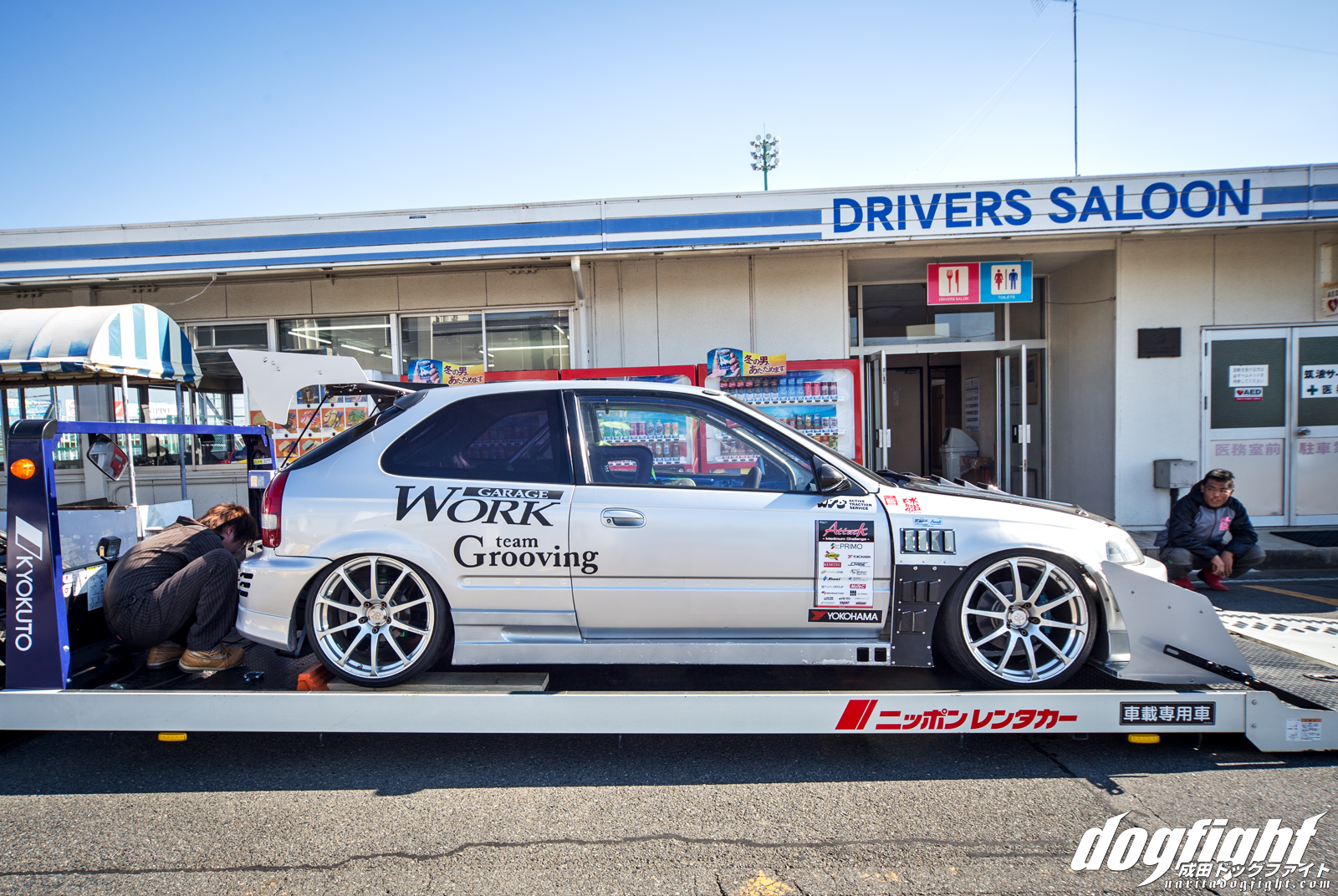 The main driver behind the Ichihara native is the desire to break the one-minute barrier at TC2000 with an engine that has been basically untouched; a goal that has never been reached before – let alone attempted. Quite possibly one of the most frustrating goals to set for oneself, but no doubt, when it’s achieved the satisfaction will be immense.
The main driver behind the Ichihara native is the desire to break the one-minute barrier at TC2000 with an engine that has been basically untouched; a goal that has never been reached before – let alone attempted. Quite possibly one of the most frustrating goals to set for oneself, but no doubt, when it’s achieved the satisfaction will be immense.
This means that Makoto is fighting for a 59 second lap only by tuning suspension, gear ratios, and reducing weight.
Take into account that this is the original engine in the car (it hasn’t even been overhauled yet), and you’ve got not only an incredibly difficult task, but one that ultimately has a time limit as the original B18C wears with each track day.
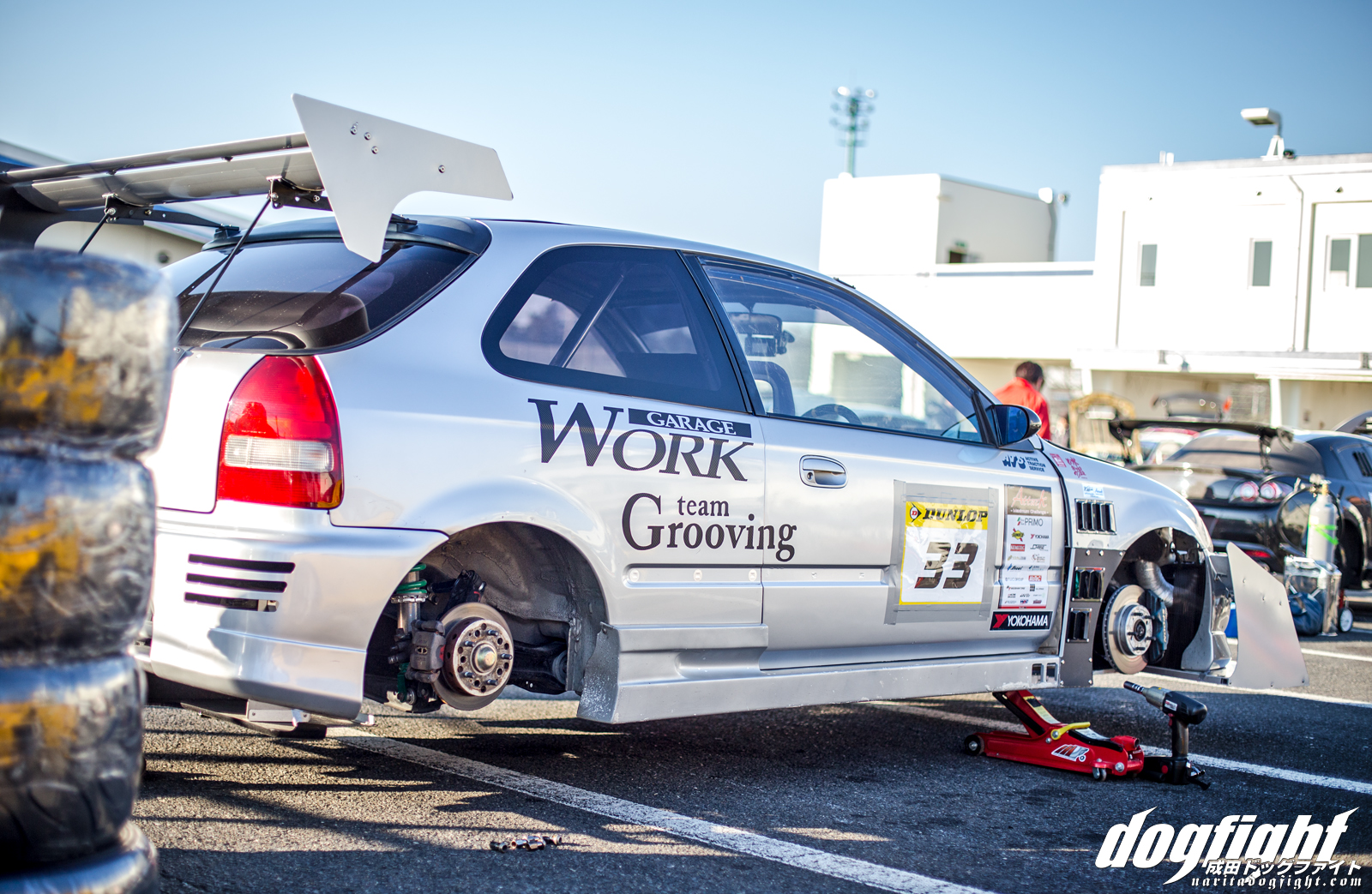 He isn’t totally unarmed in his fight, however. Garage Work, working closely with Tein, has the ability to swap spring rates and test different damper valving nearly every track event if necessary. Used to extremely high spring rates and literally no stabilizer bars, the Garage Work camp knows what they’re doing when it comes to suspension tuning. The EK4 currently has a set of Tein HT dampers valved to a custom setting.
He isn’t totally unarmed in his fight, however. Garage Work, working closely with Tein, has the ability to swap spring rates and test different damper valving nearly every track event if necessary. Used to extremely high spring rates and literally no stabilizer bars, the Garage Work camp knows what they’re doing when it comes to suspension tuning. The EK4 currently has a set of Tein HT dampers valved to a custom setting.
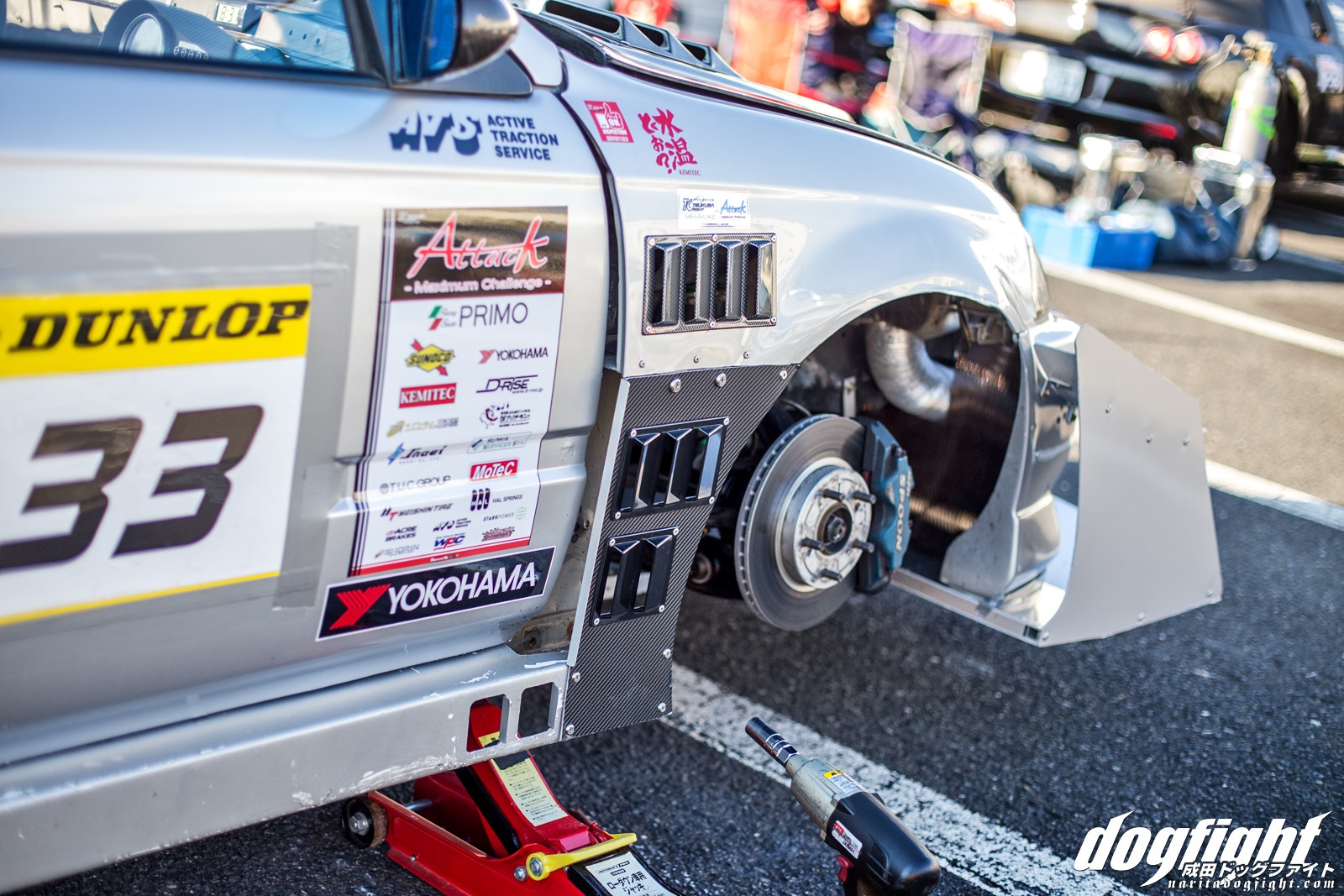 Makoto’s Civic looks pretty extreme from the outside. The custom front splitter and canard setup are his creation; along with the fender treatments as well.
Makoto’s Civic looks pretty extreme from the outside. The custom front splitter and canard setup are his creation; along with the fender treatments as well.
 OE brakes suffice in the rear, but the front brakes get the Spoon treatment with the 4-pot, twin-block calipers – which are notably lighter than the OE calipers.
OE brakes suffice in the rear, but the front brakes get the Spoon treatment with the 4-pot, twin-block calipers – which are notably lighter than the OE calipers.
 The custom vented C-West bumper allows air to flow to the OE, half-sized radiator and oil cooler.
The custom vented C-West bumper allows air to flow to the OE, half-sized radiator and oil cooler.
 Judging by this view, you would never guess that underneath the vented, carbon bonnet lies a very, unusually normal motor.
Judging by this view, you would never guess that underneath the vented, carbon bonnet lies a very, unusually normal motor.
 Save weight wherever you can! The carbon wingserts allow adjustability to the oversized GT wing on top of the hatch.
Save weight wherever you can! The carbon wingserts allow adjustability to the oversized GT wing on top of the hatch.
 A 6-point roll cage gives Makoto the added safety that you don’t typically find in builds like this. The cage does add weight, but you can’t put a price on safety. Despite this, the car weighs in at a tremendously lightweight 804kg (about 1770 pounds).
A 6-point roll cage gives Makoto the added safety that you don’t typically find in builds like this. The cage does add weight, but you can’t put a price on safety. Despite this, the car weighs in at a tremendously lightweight 804kg (about 1770 pounds).
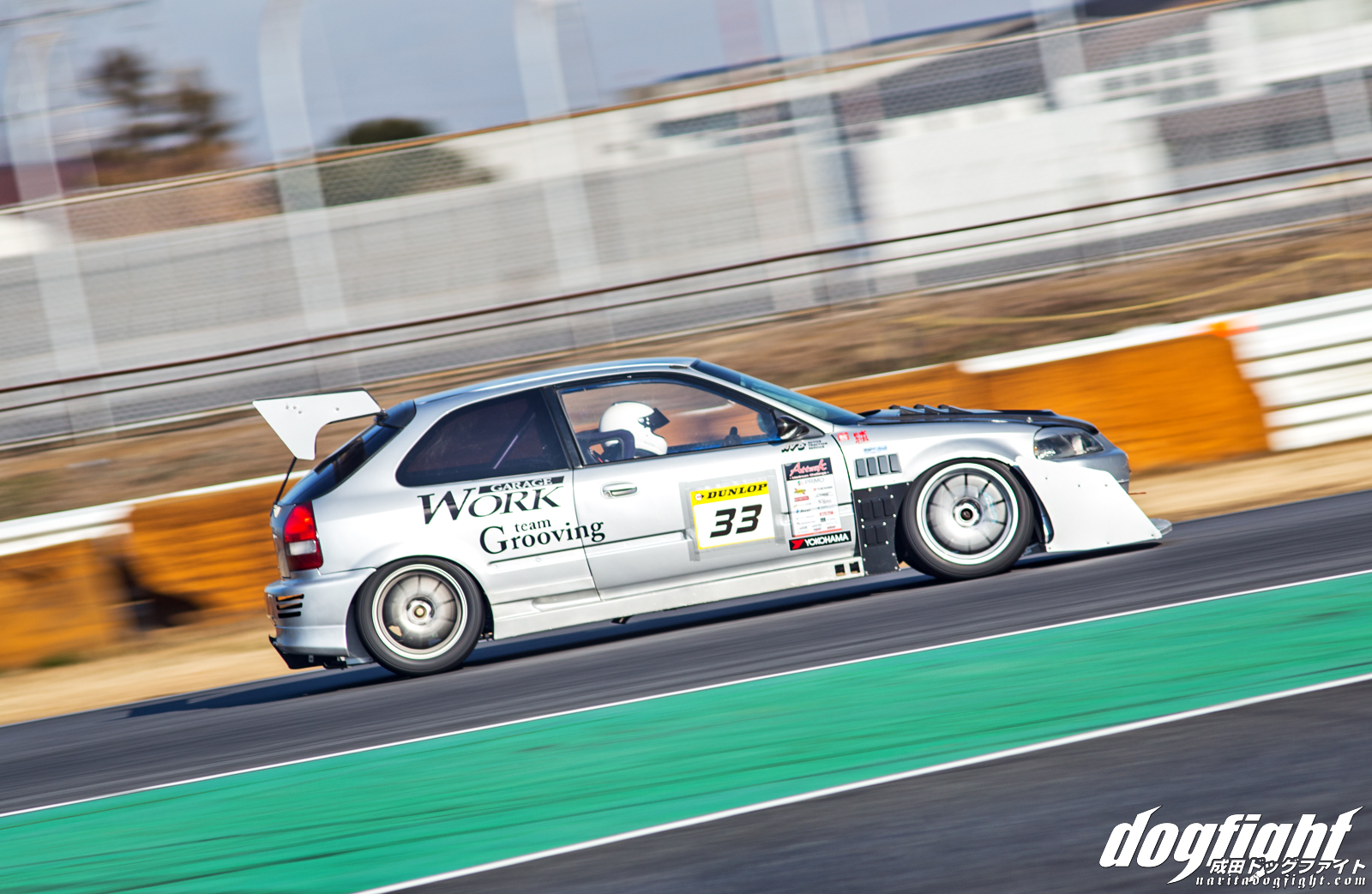 Offset sized Volk CE28’s house the Dunlop Direzza ZII Star Specs that he chooses to take on Tsukuba with during the Direzza challenges, and the Advan A050’s for when he’s going for a PB.
Offset sized Volk CE28’s house the Dunlop Direzza ZII Star Specs that he chooses to take on Tsukuba with during the Direzza challenges, and the Advan A050’s for when he’s going for a PB.
 Check out those stiff spring rates – almost on two wheels around the first hairpin.
Check out those stiff spring rates – almost on two wheels around the first hairpin.
 Quick pit stop at the Evome event in January, as Iwata and Kubo diagnose an ignition issue with the motor. The issue ended up being a bad MAP sensor that ended Makoto’s day early. He still managed to grab a 1’01.515 – 1.5 seconds off his goal.
Quick pit stop at the Evome event in January, as Iwata and Kubo diagnose an ignition issue with the motor. The issue ended up being a bad MAP sensor that ended Makoto’s day early. He still managed to grab a 1’01.515 – 1.5 seconds off his goal.
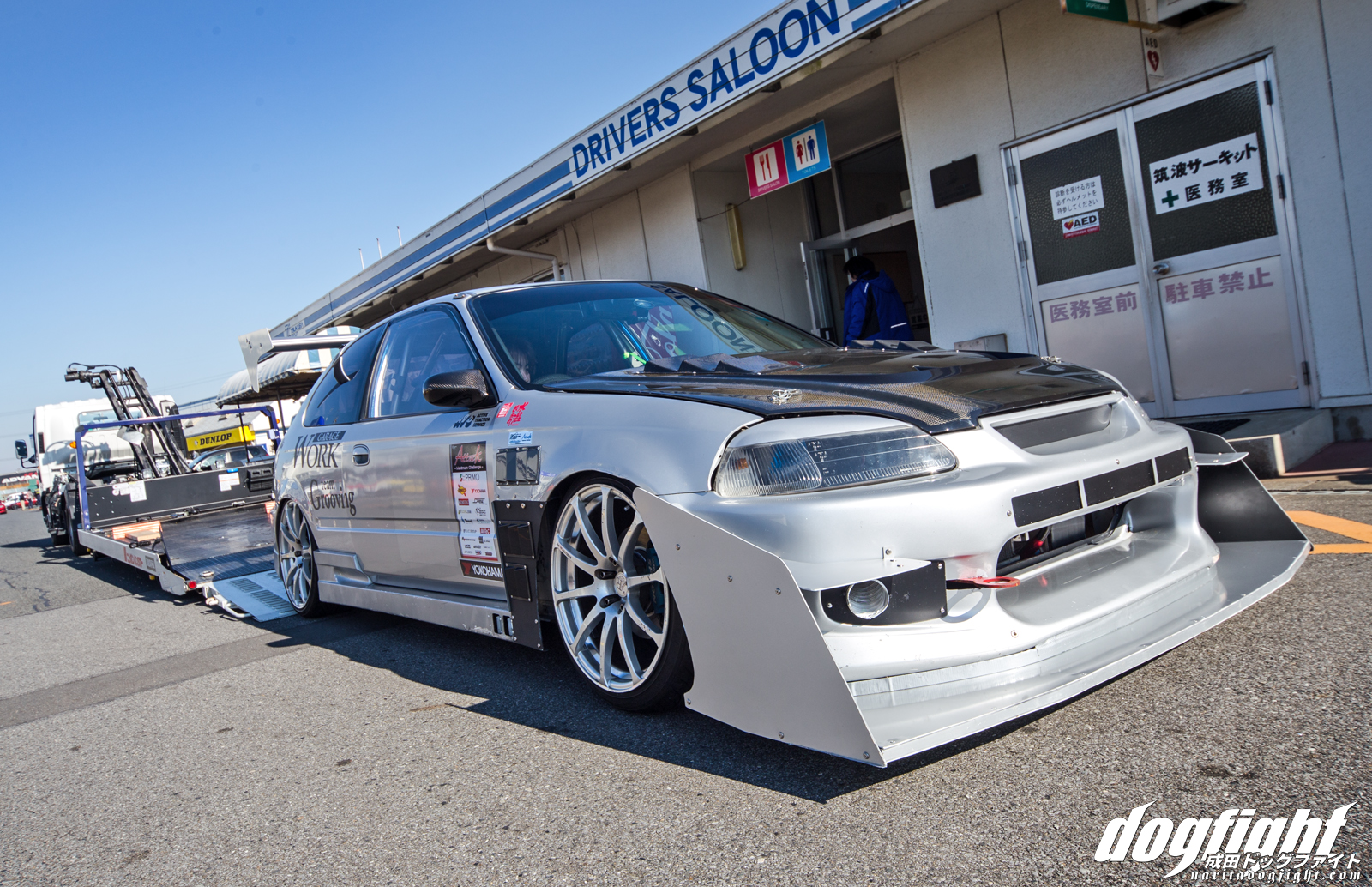 He mentioned that he may have been able to squeeze a couple more tenths out of the car that day if he didn’t have the electrical issues.
He mentioned that he may have been able to squeeze a couple more tenths out of the car that day if he didn’t have the electrical issues.
 No doubt that he’ll continue to find ways to cut time around Tsukuba, and I’d say by next season he’ll have a fighting chance at achieving his goal. Good luck まこっち ~!
No doubt that he’ll continue to find ways to cut time around Tsukuba, and I’d say by next season he’ll have a fighting chance at achieving his goal. Good luck まこっち ~!

That’s a cool challenge he’s set himself! I used to have a 130bhp Peugeot 306 that I got around the nurburgring in the 8:40s BTG, using a similar philosophy. It’s interesting that they decide to use no arbs; personally I prefer softer spring rates to maintain wheel control with a stiff arb to make the rear end loose enough. You see how much body roll it has in that hairpin -that can’t be helping maintain the contract patch!
First off, let me say that I love these Garage Work builds and I find his work to be truly inspirational and really well designed.
That being said (I am, technically a mechanical engineer with a background in auto racing), I do have some issues with the overall build, but maybe this is because the car is really a ‘work in progress’. For the purposes of this discussion, I am assuming the car is ‘finished’.
For example, if everything is being pared down to LIGHT AS POSSIBLE, why the heck do you have wing mirrors and stock headlights and brake lights on a time attack car?
Another thing, the FRONT AND REAR suspension arms look pretty stock in the pictures. Obviously, you can pretty easily get parts that will shed A TON of weight on the suspension, but that has clearly not been done. And why have 5-bolt hubs? You can easily get away with the lighter 4-bolt hubs. The 2016 Miata actually went BACK to 4-bolt from 5, and the car weighs much more than 800kg. You could AT LEAST put the rears on 4-bolts without any problems.
And those are obviously not THE LIGHTEST WHEELS you can get. I can’t imagine why the driver feels he needs low profile tires FRONT and REAR, because you don’t. In fact, you can generate MUCH more cornering power with a nice chunky sidewall, and I personally think anything over 15″ on the front is a waste. You can go bigger on the back, as you don’t need as much slip angle out there considering the tire loading.
Ok, that’s just a FEW of the obvious things, but dare I mention a couple of others.
Again, I see A LOT of these guys running POWER STEERING on a 800kg Honda? This just doesn’t make sense. And if you’re driving AT SPEED, you need all the feel you can get, and there is really nothing better than a manual rack and pinion. You can even do one better and adjust the front caster out of spec and make it easier to steer if you don’t like the resistance. For me, personally, going back to a manual rack was THE BEST MOD I ever did, especially since it IS FREE!!
On the subject of aero. IMHO, you first dial out ALL THE DRAG you can possibly handle. You don’t need a rear bumper, why is it there? If you want some vestiges, you can cut out much more than they have and save some weight, its polyurethane and is actually reasonably heavy. Additionally, it is a massive PARACHUTE slowing your car down. Also, the front bumper has TOO MANY cutouts, LESS IS MORE here. Especially considering how crappy the stock radiator is. He could do better to get a dual core radiator, and run less cutouts on the bumper. Oh, and the stock radiator, fan and shrouds ARE BRICKS, they can easily be replaced with something much lighter like an aluminum radiator with a plastic flex-a-lite fan. And if you’re really genius, you really have to cant the radiators forward so they exhaust INTO all those hood cutouts, failing that, you would need to create some ducting. Otherwise, you’re really just crossing your fingers and ‘hoping’ the heat finds its way out. Ducting isn’t that difficult to do really.
Also, any body material after or before the suspension points can be reliably removed and replaced with lighter aluminum sheet or stock. It doesn’t look like he’s running the aluminum drivers side engine mount either, which shaves considerable weight. You could probably replace the roof skin with aluminum sheet, too. The car also looks like it is running stock glass, and we know we can save 30kg reliably with riveted polycarbonate.
Honestly, if this is a 800kg car, then doing what I suggested and a few other things should get you to 650kg pretty easily.
Last but not least, for ultimate weight reduction you can DOWNGRADE the stock engine and put in a single cam D16 variant. With a D16 you get 95% of the torque of a B16 but you actually DROP about 40lbs, from what I know because you lose a cam, have a simpler head casting, and a little bit lighter bottom end. I think the D16 tranny is also marginally lighter. You can even ditch the front torque mounts if you upgrade all the engine mounts to polyurethane. Those front torque mounts are easily 10-15kg right there.
So, I sincerely hope I don’t sound like a jerk. Obviously, I spent way too much time in college, and after, obsessing about race cars. But these guys are my inspiration and if I can truly give anything back, then some gentle, persuasive reminders might be it. Also, I am assuming that the car is ‘finished’ which no project car truly ever is, and so it may have a rash of updates that would take care of a lot of the stuff I mentioned.
As always, I love the site. Keep it coming. Thanks, Sean.
Hi Joe; you get the award for longest comment. Let me see if I can try to answer some of your questions with my own knowledge of their builds. Mirrors and stock headlights; because most of these are street registered cars. You can’t drive at night without headlights. Quite a few of the Work cars have custom aluminum rear trailing arms. They run 5-lug because of the wheel sizes the use; typically 17×9.5~. They don’t run 15’s up front because you can’t get the grip you need with a 195 or 205 series tire (which are typical of that size); if you think running anything larger than a 15″ wheel up front is a waste, then your logic is flawed – more tire, more grip. They run power steering because of the tire size and driving style – if you say at speed nothing is better than a manual rack, then may I ask why F1 cars use power steering? Dual core radiators are heavier than stock, and they aren’t running more than a few laps at a time; larger radiators are not necessary. The cars do not have stock glass; they use poly or carbon. Hope that helps answer some of your questions.
Thanks Sean, those are all reasonable answers. I do have some radical solutions to drop weight on the Civic chassis that I don’t see a lot of builders do. Needless to say, I’m always excited about new developments for this ‘classic’ EG6 chassis.
Awesome looking car, thanks for the share!
I’m glad to see that this car has a cage. That EG without one seems scary to me.
Pingback:Feature: All In A Day’s Work – Chiba’s EK Frontrunners